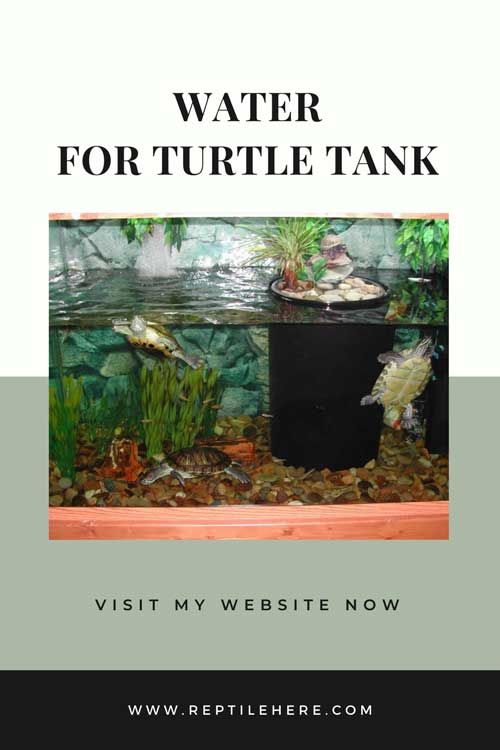Water For Turtle Tank: What Kind? How Much? When to change?
If you’re just getting started setting up your turtle tank, one of the things to pay attention to is the quality of water you use. You want to ensure you only use safe water for your turtle’s habitat for swimming in and for drinking to ensure it stays in good health.
The right kind of water for turtle tank that’s safe to swim and drink for your pet turtle should be 6.0-8 or simply natural spring water. Avoid using your regular tap water for turtle tank since it usually contains chemicals that affect the water pH balance and can even harm your turtle.
In this guide, you’ll discover more information on what kind of water is safe for use in the turtle tank. We have also shared more details on how much water to put in your tank, when you should change the water, and other helpful information you need to know about water for turtle tanks.
What kind of water does a turtle need?
Contents
Aquatic turtles spend a lot of time in the water swimming in the water you put in their tank. They also drink and eat in the same water. Thus, you should be careful about the quality of water you put in your turtle tank.
That said, the right kind of water for your pet turtle is one whose pH falls between 6.0 and 8 or natural spring water.
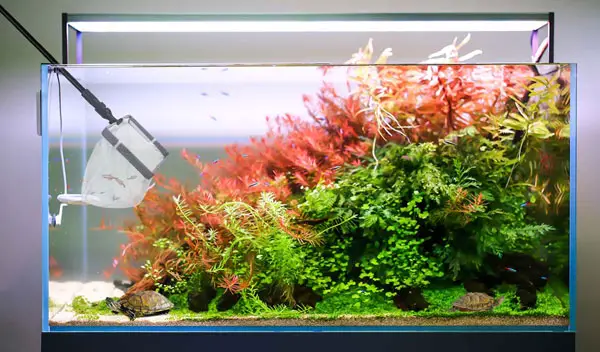
Essentially, the right water for a turtle tank is all about having the right chemical levels. While turtles are less sensitive than fish, you should still be careful about the water pH, chlorine nitrate/nitrite, and ammonia levels.
In brief, the right water for turtle tank should have the following chemistry:
- pH level: between 6.0 and 9
- Chlorine levels: 0
- Ammonia level: 0
- Nitrite level: 0.5 ppm or less (ppm stands for parts per million)
- Nitrate level: 40ppm or less
If your turtle tank water meets the above chemical composition, then your pets will be quite happy in this habitat.
This water composition works for most North American turtle species, i.e. the hard-shelled turtles like the red-eared slider. Softshell turtle species are more sensitive, so make sure their pH doesn’t go lower than 6.5
But if you’re keeping a more exotic species, then you may want to consult your exotic pet vet for more info about that specific species.
A slightly acidic pH of 6.0 to 6.9 is recommended for most turtles to help slow down bacteria and fungi growth in the turtle tank.
But if you go with water with a pH lower than 6.0, it is likely to start irritating the turtle’s eyes. Beneficial bacteria living in the filter will also be unable to withstand such acidic levels.
Can you put regular tap water in a turtle tank?
We don’t recommend using regular tap water in a turtle tank because it usually contains chlorine and fluorine chemicals which affects the water’s pH and affects the health of your turtle.
However, if you must use tap water for your pet, then you should make sure it is. If it is not, you should first treat it and dechlorinate it so that it is safe for your turtles.
High levels of chlorine in tap water, for instance, can hurt your turtle’s eyes and make them appear squinted. The unbalanced pH of untreated tap water can also distress your turtle’s health.
What’s more, if you use untreated tap water in your turtle tank, it will end up killing the healthy bacteria colony. Good bacteria are responsible for the prevention of ammonia in the water, so messing with it will make your turtle water unhealthy and contaminated.
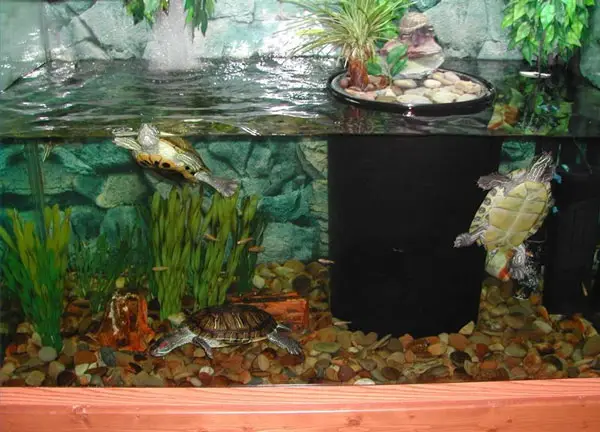
Even if you believe the water coming out of your tap is of good quality, you should still take it through a treatment process to get rid of chlorine and other chemicals that can harm your turtle’s health.
Most cities and counties usually publish their water quality water reports, so telling whether the water in your sink is of good quality shouldn’t be hard. Focus on the levels of pH, chlorine, and other chemicals your municipality may have added to the water for easy transmission and storage.
Using a turtle water conditioner is the easiest and safest way to effectively get rid of the undesired chemicals in the tap water and make it safe for your pets. The conditioner also does a great job at detoxifying heavy metals from the water while some may even support the growth of healthy bacteria in your aquarium.
Alternatively, you can let the water sit outside for up to 24 hours; this will give you the same results as a water conditioner. The sun’s UV rays will help dissolve the minerals inside the water, making it clean and safe for your turtles to reside in.
How much water should be in a turtle tank?
As the rule of thumb goes, the right amount of water to have in a turtle tank is 10 to 15 gallons of water for every inch of the turtle shell. This is the right amount of water to ensure your turtle can swim comfortably in the tank.
Still at it, you should make sure the turtle tank water depth falls at least ¾ the total length of your turtle. This ensures the water is deep enough for your pet to flip upright if it accidentally turns upside down while inside the water.
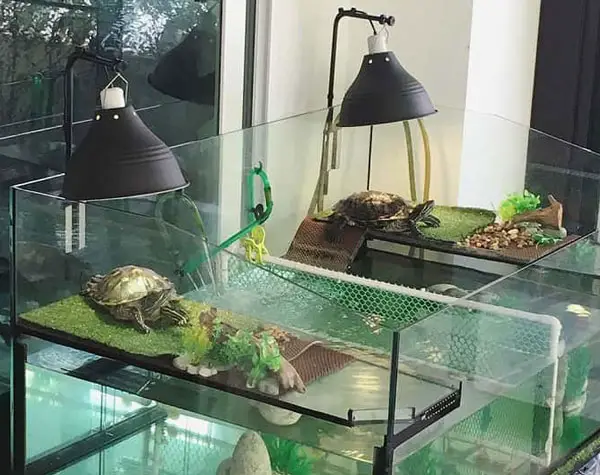
That being said, the amount of water you put in a turtle tank will also depend on your pet turtle species, whether you have an aquatic or semi-aquatic turtle.
It goes without saying that an aquatic turtle will require most of its tank filled with water. We advise you to have at least 60% of your tank capacity filled with water if you own a fully aquatic turtle. But don’t forget to provide your pet with a dry spot for basking and drying off.
For a semi-aquatic turtle, e.g. the box turtle, the right amount of water should be around 25% of the total tank capacity. This turtle will require a mixture of water that occupies a few inches deep plus a terrestrial environment.
Can turtles live in a tank full of water?
Absolutely no! It is not recommended to put your turtles in a tank full of water. Unlike fish, turtles lack gills and aren’t good at breathing underwater, so they will easily drown if you fill their tank with water.
Turtles in the wild spend some time on the surface rather than swimming in the water. The reason the turtles come to the surface is to breathe as they’ve got developed lungs. If they remain completely submerged in water, then they won’t be able to breathe (unless they do butt breathing) they’ll most likely die in a matter of days.
Most turtles will stay underwater for hours without any issues but they’ll still need to pop out of the water momentarily to catch a breath. Even turtles without developed lungs that can stay underwater for longer periods of time will still easily drown if left submerged.
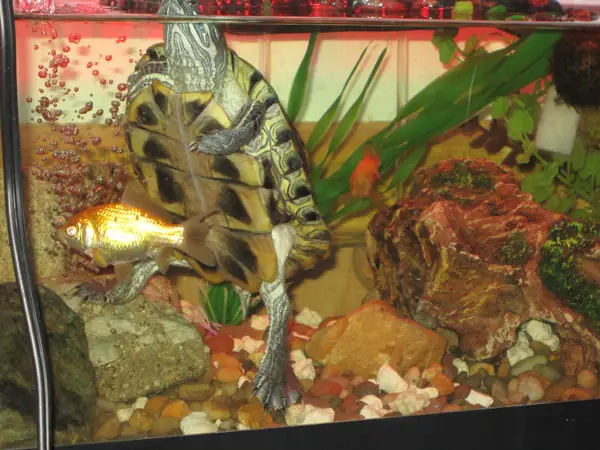
Another reason not to fill the tank with water is that the turtle will come to the surface to bask under the heat lamp or sunlight. This is necessary for drying off and healthy shell growth.
Overall, you shouldn’t put your turtles in a tank full of water. To ensure you get the water level right, follow our rule of thumb which requires you to put 10-15 gallons of water in the tank per every inch of your turtle shell.
When to change water in turtle tank?
You should change your turtle tank water at least once a week to help keep your turtle habitat clean. And you should only do a partial 25 to 50% water change to avoid messing with the water parameters required for a healthy turtle aquatic environment.
A partial 25-50% water change ensures you get rid of old water and replace it with new, clean water. It also helps lower the levels of nitrite and ammonia in the water which can easily affect your turtle’s health.
Make sure you do the water change using clean water only. Even if your turtle tank water appears fine, it could be concentrated with ammonia or nitrites, so it is a good practice to do the changes once every week.
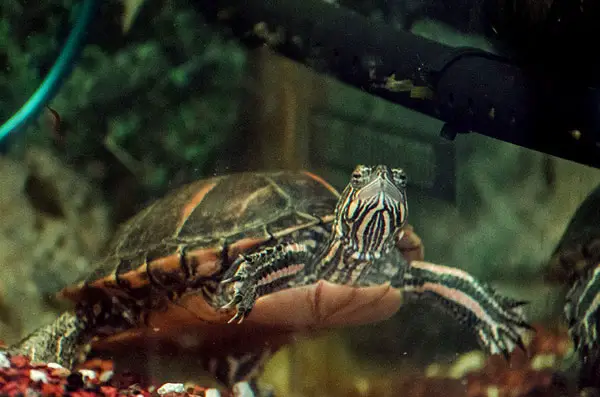
The only time you’d want to consider a complete water change and clean the filter is when debris has started building up in your aquarium or you noticed restricted filter flow. Even then, you should still observe a 2-3 times a month cleaning interval for your tank filter.
That being said, here are a few additional tips you can follow to keep your turtle tank water clean for longer:
- Use a small net every day to get rid of any uneaten food and turtle droppings
- Get a more powerful filter, a power or canister filter will do, to keep your turtle’s habitat filtered.
- Every few days, test the water pH with the help of a test kit (these are readily available at pet stores)
- Clean out the entire tank every 2-3 weeks and refresh the filter
How to change water in turtle tank?
A water change is a pretty simple exercise to do in your turtle tank. You simply use the siphon hose to remove some of the water from the aquarium into the bucket and then replace it with fresh water.
You usually do a partial water change which involves replacing just a quart of water with every water change session. The partial water change is only applicable if there are no issues in your tank. If you’re correcting an issue with the aquarium, however, you can replace more water—up to half or all of it.
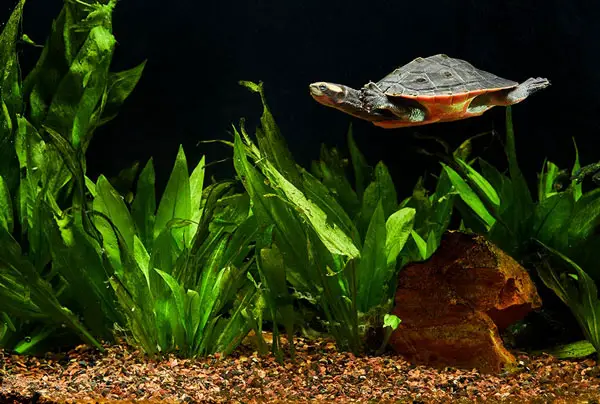
During a water change, be sure to turn off your tank water heater(s) and give them enough time to cool down in case the water levels will drop below the level of the heater. This is a necessary precaution since electric heaters tend to burn out immediately after they’re operated out of water.
Is distilled water safe for turtles?
Distilled water is safe for turtles and doesn’t even require conditioner as it contains no harmful chlorine and other additives that are present in regular tap water. The pH of distilled water is also neutral (7.0), which is a safe level for a sensitive turtle or exotic turtle species.
Unfortunately, distilled water can be an expensive option to use for refilling your turtle tank. You can get it at grocery stores. Note that many stores usually have water filters as well, so getting larger amounts of this kind of water shouldn’t be a problem for you.
Keep in mind that distilled water has been stripped of important minerals that are necessary for your turtle’s health. So you should consider remineralizing it (i.e., putting some minerals in it such as calcium and iron) before using it in your tank.
What do I need to put in my turtles water?
Besides having clean water in your turtle tank, you’ll also need to introduce other necessary items in the water to ensure a comfortable living environment for your pet.
One such important item is a basking spot where your turtle can dry itself off, rest, and sun. You can also introduce a substrate in the water to keep it clean and free of diseases.
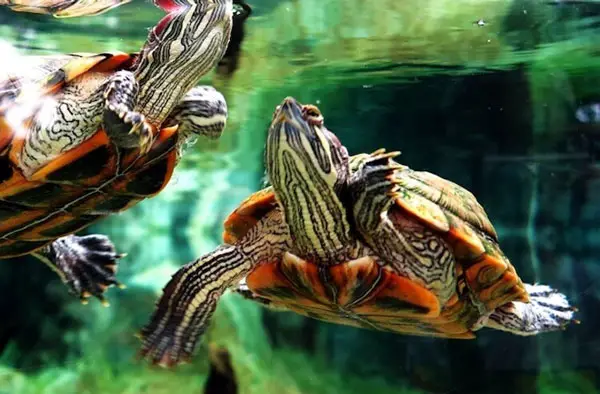
Consider introducing several gravel substance inches (use gravel that’s too big to fit in the turtle’s mouth). A well-anchored wood will make a good basking dock. You may consider using African root or smooth stable stones. Plexiglas planks and ramps can also work.
A good basking platform should allow the turtle to easily get out of water when it needs to rest, catch a breath, or sun, etc., without being able to climb out of the tank.
Can I use bottled water to refill my turtle tank?
You can use quality bottled water to refill your turtle tank as this kind of water is generally safe to consume. However, bottled water is expensive, and going this path means putting an unnecessary burden on your bank account.
However, you should make sure you only use high-quality bottled water from reputable brands. Otherwise, you may end up with bottled water that may contain impurities that can cause harm to your turtle.
Something else to keep in mind about bottled water is that it has gone through the reverse osmosis purification process, depriving it of important minerals which make up a healthy diet for your turtle.
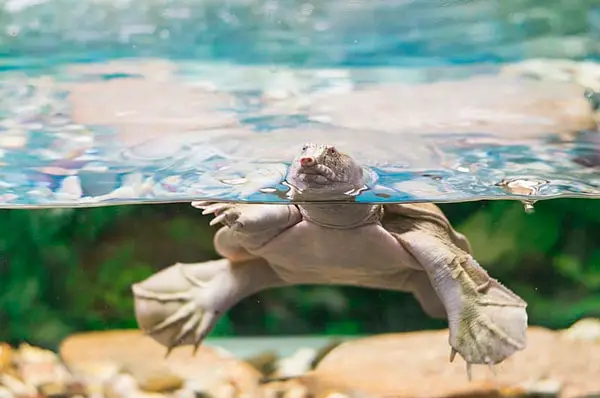
Instead of spending money on bottled water and risking getting low-quality bottled water, simply use spring water or treated tap water to refill your turtle tank.
For tap water, just make sure you take it through a treatment process with the help of a turtle water conditioner or simply leave it outside on a sunny day for up to 24 hours.
Related questions:
The water in a turtle tank should be around 4-6 inches deep for most turtle species. Or you can follow the rule of thumb which states that the water depth should be at least three-quarters the shell length of your pet turtle. This is the perfect depth to enable your turtle to swim comfortably and even enable it to flip itself right in case it accidentally turns itself upside down inside the water.
The ideal water for most turtles is one whose temperature is close to room temperature (i.e., between 68 and 77 degrees F). Turtles are cold-blooded creatures and can’t control their body temperatures. As such, putting them in too cold water may make them sick. Likewise, you shouldn’t put them in water that’s too warm that they feel uncomfortable in it.
The right amount of water should be at least an inch deeper than the width of your baby turtle’s shell to ensure your pet turtle swims freely.
Final Verdict
The right kind of water to use for your turtle tank should have a pH of between 6.0 and 8. It should also be free of chemicals such as chlorine and fluorine which can harm the health of your turtle.
Natural spring water is generally considered safe for your turtle tank. Tap water is also safe but you must first treat it to get rid of harmful, undesired chemicals. Distilled and bottled waters are also safe options for use in your turtle tank but they can be expensive and have important minerals stripped off so it’s not healthy for your turtle to drink.
Be sure to change the turtle water regularly to ensure your pets stay in a clean and healthy environment. Hopefully, this guide has taught you everything you need to know about water for turtle tank.
